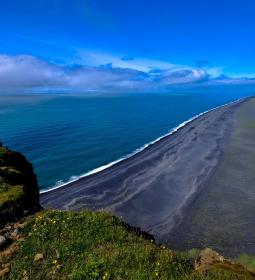The sea is beautiful, but at the same time insidious and dangerous, even if you are a great swimmer. Along the beaches, signal signs are often displayed warning of dangerous coastal streams. Swimming in such areas is life-threatening. What can we say about large underwater streams that affect the climate and weather of entire regions and countries!
Streams can be superficial and underwater, warm or cold, occur periodically or be constant. On average, the speed of streams does not exceed 5 km / h, but there are exceptions.
South Trade Winds in the Atlantic Ocean
The stream originates from Bengal, passes near Africa and has two directions:
- To Antarctica, becoming part of the Brazilian
- To South America, becoming part of the Caribbean.
The water temperature averages 32°C. It is caused by constant winds of trade windsthat blow from east to west. The average speed is 20-65 km / day.
Southern Trade Winds in the Indian Ocean
Form the flow of wind-trade winds. The average speed is 60 km / day, and the temperature is 25-26 ° C. The stream overcomes the path from Australia to Africa and also has two branches:
- Madagascar
- Mozambican.

Somali Stream
It is named after the island of Somalia, where the waters of the current sweep. Cause it monsoons,so the current is unstable in nature and water temperature. Deep waters rising in summer are directed to the northeast, the average water temperature drops to 13 ° C. In winter, the direction of the current changes and moves to the southwest, the water temperature during this period is around 26 ° C. Speed 75 km / day.
East Australian Stream
It is one of the branches of the South Trade Winds of the Pacific Ocean. Its waters run along Oceania off the coast of New Zealand and Australia. This warm current with an average temperature of 25°C brings with it a tropical, humid climate. The speed varies from 50 to 90 km / day. The East Australian Current became a thoroughfare for the characters of the cartoon "Finding Nemo".
Stream of Cape Needle
The waters run along the coast of Africa through Cape Needle. It is also called Agulhas. Probably, the name is associated with the sharp rocks, where many Portuguese ships found their last refuge. The speed of the current reaches 90 km / day, this is one of the constant currents of the world ocean. Agulhas originates from the Indian Ocean, then its waters mix with the cold waters of the Atlantic, giving rise to the Transverse Current.
Mozambique Stream
The longest constant current in the world is Mozambique. It runs along the Mozambique Strait between Madagascar and Africa. In the south, the current becomes part of the Needle. The average water temperature is 25 ° C, and the speed is 70-90 km / day.

Florida Stream
Between Cuba and the United States is the Florida Current. It originates from the Caribbean, then flows into the Antilles current and becomes the Gulf Stream. This large current develops a speed of up to 130 km / day.
Kuroshio Stream
Off the coast of Japan is a warm current Kuroshio - "dark / black" in translation into Russian. It carries water from the south-east and softens the climate on the islands. In the north, Kuroshio becomes part of the Soya Current. The speed varies from 20 to 144 km / day, the temperature in winter is 12-18 ° C, in summer - 28 ° C.
Gulf Stream
It is the second largest current in the world. The Gulf Stream consists of many warm currents that are part of it. The waters of the Gulf Stream pass near the coast of the United States,heading for the Oceans. Faced with the Labrador Current, where the water is cold, the Gulf Stream loses heat, but still has a beneficial effect on the climate of Europe, making it softer. Further, the Gulf Stream dissolves and becomes part of other currents, its echoes are noticeable even in the Arctic Ocean. The speed of water movement is from 72 to 144 km / day.
South Trade Winds in the Pacific Ocean
The world's largest current in the Pacific Ocean. Its origins originate in South America, rushing to Australia and New Zealand. This is the widest and fastest current with a speed of 185 km / day and an average temperature of 32 ° C.











